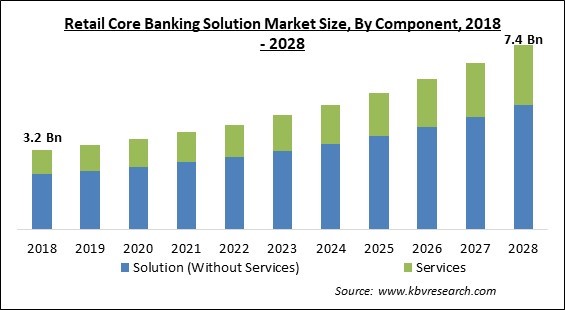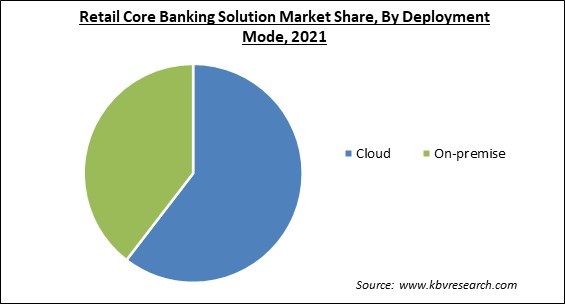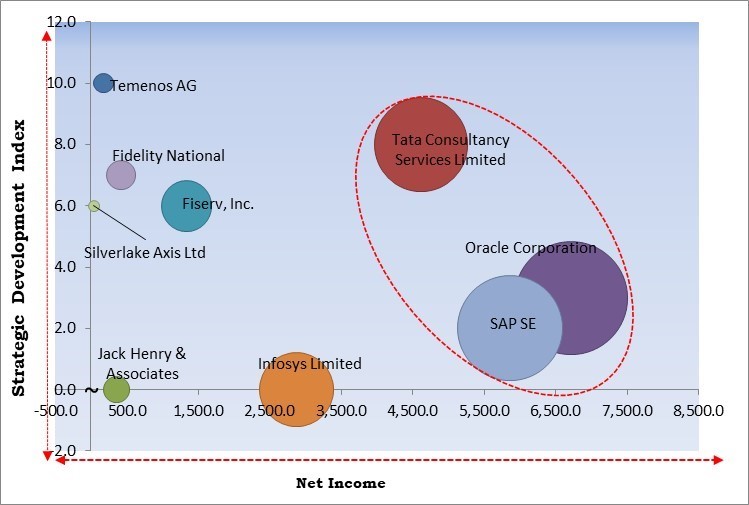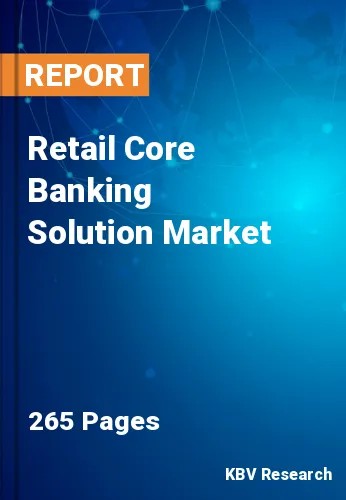The Global Retail Core Banking Solution Market size is expected to reach $7.4 billion by 2028, rising at a market growth of 9.8% CAGR during the forecast period.
One of the key aspects influencing the market growth is how well the retail core banking solutions help clients manage their finances over a secure channel and provide flexibility in accessing their bank accounts. Additionally, the use of retail core banking solutions gives low-cost funding to banks, aids in their establishment, and maintains an efficient Customer Relationship Management (CRM), which are all predicted to propel market expansion over the course of the projection year. The sector is also growing due to customer mobile and online banking demand.

Banks are under pressure to implement better tactics that may offer their customers straightforward payment options due to the increasing competition from different mobile payment wallets and other Fintech applications, which is expected to drive the market's growth. The competitors in the market are also focusing on new product launches to maintain a competitive edge.
For instance, Temenos AG unveiled its Temenos Transact Data Hub in October 2020. It is a real-time core banking Software-as-a-Service (SaaS) platform. Modern banks must employ the data capabilities Temenos Transact Data Hub provides to fully realize the value of the data housed within the core banking platform. Retailers, technology suppliers, and Fintech start-ups are just a few examples of non-traditional companies that are technology-driven, customer-focused, and nimble.
By concentrating on the most profitable parts of their value chains, such as mobile payments, they harness cutting-edge technologies to provide customers with improved accessibility, higher service, and affordability. Peer-to-peer (P2P) lending was introduced to remove complicated procedures. As a result, these businesses are establishing themselves as strong rivals to conventional banks.
To slow the spread of COVID-19, it is advised that most bank employees globally work remotely. The COVID-19 program is also putting customers' long-standing banking habits to the test. Consumers should switch to contactless payment and avoid handling large bills, according to the World Health Organization (WHO). This is because COVID-19 may spread more quickly if it can survive on a note for days. By integrating digital and remote customer transactions, banks can guarantee that ordinary and exceptional operations will be carried out with little trouble. This suggests that the use of IoT in banking will increase over time.
Due to their many high-throughput and productivity-boosting uses, networked technologies like edge computing and IoT devices are gaining significant popularity on the global market. Additionally, many vendors are producing IoT devices, boosting the penetration of linked devices in the contemporary business environment. Radiofrequency identification (RFID), low-energy Bluetooth, near-field communication (N.F.C.), low-energy wireless, LTE-A, low-energy radio protocols, and Wi-Fi-direct are standard protocols and technologies used by IoT systems.
IoT impacts banking customer service in various ways. Customers receive timely insights and a personalized experience. Visitors can make an appointment and verify it in their smartphone due to device connectivity. Customers now understand when it is their turn to stand in line rather than wait at the counter. Additionally, the bank maintains a record of each customer's appointments, the services they utilize each time they come in and any questions they may have.
The biggest barrier to IoT adoption is data protection and security, which is addressed by most of the banking sector. The banking industry is closely regulated by strict compliance with standards and governance since any data breach, or security breach might be fatal. Businesses are feeding increasingly more user and provider data into sophisticated, AI-powered algorithms, creating novel personal data without being aware of how it will affect customers and employees. This subsequently fuels the escalating privacy concerns.
Based on Component, the Retail Core Banking Solution Market is classified into Solution (without services) and Services. The Services segment registered the significant revenue share in the Retail Core Banking Solution Market. Modern banks need several complex systems to work together to ensure continuous service delivery and reliability. The retail core banking services model ensures that all the systems are managed at once and have outstanding usability, complete functionality, bug fixes, and timely upgrades.

Based on Deployment Mode, the Retail Core Banking Solution Market is classified into Cloud and On-premise. The on-premises segment accounted for the substantial revenue share in the Retail Core Banking Solution Market during 2021. The banking organization favors on-premise solutions because of their many benefits. One of these benefits is total risk reduction because the data is controlled and hosted on private servers.
Based on Organization size, the Retail Core Banking Solution Market is classified into Large Enterprises and Small & Medium Enterprises. In 2021, the Small and Medium Enterprises segment showcased the considerable revenue share in the market. The segment is anticipated to rise due to S.M.E.s' evolving need to adapt their operations and financing facilities and their growing demand for flexibility. The increasing S.M.E. ecosystem is also accelerating the desire for S.M.E.s to install retail core banking products, which will likely accelerate the segment's growth.
Based on application, Retail Core Banking Solution Market is divided into Regulatory Compliance, Risk Management, Digital Banking, and Others. In 2021, the regulatory compliance segment acquired the highest revenue share in the market. The dominance might be attributed to the importance of client data protection in the banking industry. Every data breach or internet attack could cause irreversible harm to a business. One advantage of a tailored solution is the capacity to provide extra protection layers.
| Report Attribute | Details |
|---|---|
| Market size value in 2021 | USD 3.9 Billion |
| Market size forecast in 2028 | USD 7.4 Billion |
| Base Year | 2021 |
| Historical Period | 2018 to 2020 |
| Forecast Period | 2022 to 2028 |
| Revenue Growth Rate | CAGR of 9.8% from 2022 to 2028 |
| Number of Pages | 265 |
| Number of Tables | 423 |
| Report coverage | Market Trends, Revenue Estimation and Forecast, Segmentation Analysis, Regional and Country Breakdown, Competitive Landscape, Companies Strategic Developments, Company Profiling |
| Segments covered | Component, Deployment Mode, Organization Size, Application, Region |
| Country scope | US, Canada, Mexico, Germany, UK, France, Russia, Spain, Italy, China, Japan, India, South Korea, Singapore, Malaysia, Brazil, Argentina, UAE, Saudi Arabia, South Africa, Nigeria |
| Growth Drivers |
|
| Restraints |
|
Based on geography, the Retail Core Banking Solution Market is categorized into North America, Europe, Asia Pacific, and LAMEA. North America led the Retail Core Banking Solution Market with the largest revenue share in 2021. Due to significant continuous technological advancements in core banking solutions and acceptance by well-known firms like Canadian Western Bank and HSBC Holdings plc, the dominance is predicted to last over the projection period.
Free Valuable Insights: Global Retail Core Banking Solution Market size to reach USD 7.4 Billion by 2028

The major strategies followed by the market participants are Partnerships. Based on the Analysis presented in the Cardinal matrix; SAP SE, Oracle Corporation, Tata Consultancy Services Ltd. are the forerunners in the Retail Core Banking Solution Market. Companies such as Infosys Limited, Fiserv, Inc., and Fidelity National Information Services, Inc. are some of the key innovators in Retail Core Banking Solution Market.
The market research report covers the analysis of key stake holders of the market. Key companies profiled in the report include Oracle Corporation, Fiserv, Inc., Temenos AG, Tata Consultancy Services Limited, SAP SE, Infosys Limited, Fidelity National Information Services, Inc. (FIS), Kiya.ai, Jack Henry & Associates, Inc. and Silverlake Axis Ltd.
By Component
By Deployment Mode
By Organization Size
By Application
By Geography
The global Retail Core Banking Solution Market size is expected to reach $7.4 billion by 2028.
Increase in applications for IoT solutions in banking sector are driving the market in coming years, however, Rise in the cases of data and security breaches restraints the growth of the market.
Oracle Corporation, Fiserv, Inc., Temenos AG, Tata Consultancy Services Limited, SAP SE, Infosys Limited, Fidelity National Information Services, Inc. (FIS), Kiya.ai, Jack Henry & Associates, Inc. and Silverlake Axis Ltd.
The Large Enterprises market is generating high revenue share in the Global Retail Core Banking Solution Market by Organization Size in 2021; thereby, achieving a market value of $4.9 billion by 2028.
The Solution (Without Services) market is leading the segment in the Global Retail Core Banking Solution Market by Component in 2021; thereby, achieving a market value of $5.0 billion by 2028.
The North America market dominated the Global Retail Core Banking Solution Market by Region in 2021; thereby, achieving a market value of $2.4 billion by 2028.
Our team of dedicated experts can provide you with attractive expansion opportunities for your business.

